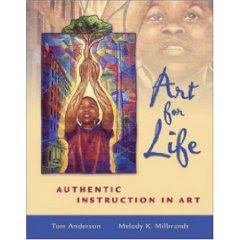Notes on Semiotics: Inscribing a Place between Formalism and Contextualism
Drawing on Semiotics: Inscribing a Place between Formalism and Contextualism
Author(s): Carol S. Jeffers
Source: Art Education, Vol. 53, No. 6, Enlarging the Frame (Nov., 2000), pp. 40-45
Published by: National Art Education Association
Stable URL: http://www.jstor.org/stable/3193882
Accessed: 04/09/2009 10:48
“The theories-formalism (universalism) and contextualism-invoke very different conceptions of art; for example, the former values art for art's sake, while the latter embraces the functional value of art”
“As Anderson and McRorie describe, a program skewed in a formalist direction emphasizes "individual creativity, skills development, and compositional excellence," while a contextualist program focuses on "collaborative experience and social issues" (p. 13).”
“More specifically, formalism/universalism is characterized by an essentialist view that sees form as paramount. Indeed, form is self-referential and universally communicates issues of pleasure and beauty to all who respond. The viewer's (and student's) task is to read and appropriate the meanings that reside within these aesthetic forms and to appreciate their intrinsic beauty.”
“Contextualism, as the name suggests, sees context as paramount and holds that the meaning and worth of art can only be determined in the context in which the work was made and used. In this view, the meaning of a work of art does not reside within its form, but rather, is constructed in the context of its cultural, historical, social, or political functions. The viewer's (and student's) task, then, is to construct meanings about the work in these contexts-which themselves have constructed meanings.”
“Anderson and McRorie (1997) go on to say that "neither a purely formalist aesthetic position, with its emphasis on elements and principles, media exploration, and originality, nor a purely contextualist one, with its emphasis on communication and socially-relevant subject matter, is adequate to ground a comprehensive art program" (p. 13). They advocate a combination of the two approaches”
“Semiotics, as a powerful and versatile tool, facilitates our explorations and the process of combining formalist and contextualist approaches.”
“Semiotics is an "approach to understanding the nature of meaning, cognition, culture, behavior, and life itself” (Smith- Shank, 1995, p. 23)”
“Semiotics also can be understood in a somewhat narrower sense as the "systematic study of signs," when signs are understood as "anything-a word, a gesture, an object, [a line]-that represents something or someone" (Danesi, 1994, p. 2). From this perspective, art forms such as drawing, painting, and sculpture are seen as signs and "texts constructed in the visual mode" (Danesi, 1994, p. 77)”
“Developing a Curriculum In-Between”
“Specifically, I introduce these students to (Barbara) Edwards's concept and practice of "analog drawing." Analog drawing involves the use of line only (and avoids the employment of graphic symbols altogether) to represent portraits, problems, or emotions such as anger, joy, love, and depression.”
“Such lines can be read as signs of these emotions.”
“I also asked my students to represent complex and otherwise abstract social issues in analog form”
“Exploring a Place Between”
“To study what actually happened, I submitted the resulting drawings to a group of graduate students who served as independent viewers and raters”
“The raters identified a number of recurring patterns in the representations of the various social issues.”
“Semiotics facilitates understandings of these drawings as signs of student experiences shaped by personal opinion and social values, by this hybridized approach to teaching, learning, and curriculum design, and by individual membership in contemporary American society.”
“Semiotics not only allows for the exploration of this place (a place between formalist/universalist and contextualist theoretical position), it also calls into question the adequacy of either formalism/universalism or contextualism to explain art-making in the classroom”
Subscribe to:
Post Comments (Atom)






No comments:
Post a Comment